
| What is Flavor and Fortune? |
| How do I subscribe? |
| How do I get past issues? |
| How do I advertise? |
| How do I contact the editor? |
Read 13074494 times
Connect me to:
| Home |
| Articles |
| Book reviews |
| Letters to the Editor |
| Newmans News and Notes |
| Recipes |
| Restaurant reviews |
| Article Index (all years, slow) |
| List of Article Years |
| Article Index (2025) |
| Article Index (last 2 years) |
| Things others say |
| Related Links |
| Log In... |
| Authors |
| Categories & Topics |
Taiwan and a Popular Recipe
| by Jacqueline M. Newman |
Regional Foods
Winter Volume: 2019 Issue: 26(4) pages: 12 to 14
This island nation, a constitutional democracy since 1912, is officially known as the Republic of China or ROC. In 2018, it had some twenty-four million people and was the fiftieth most populous country in the world. It also had people of twenty-five different religions, About twenty percent were Buddhist, five percent Christian, two percent Muslim, and one percent Jewish. Many did not answer the question about religion so perhaps they practice none. As to the question about language, ten percent said they speak Hakka, seven times that number said Hokkienese, the rest reported speaking many Chinese dialects.
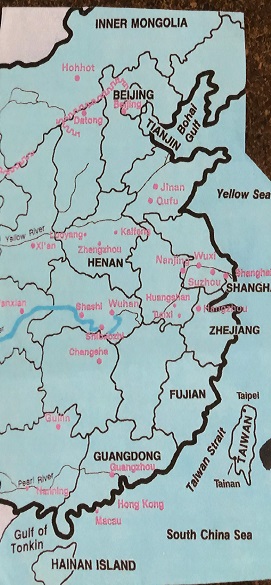
People in Taiwan love food, eat it often at home, at a street-stall, an elegant dining place, or elsewhere. They eat it as meals or snacks, consume one or the other many times a day, discuss it often, have two or more soups at most main meals, three or more at a banquet, and they devour birds roasted or as Peking Duck at most of them. They enjoy other fowl often, too, gorge on dumplings, meats, vegetables, and staple foods, and love their local popular dish, a ‘three-cup’ something or other, Three-cup Chicken is a favorite. Seems the history of this country, many Taiwanese told us, revolves around food; they speak of it often, eat some many times a day, know their country has many types and qualities, and say they even can enjoy them all.
Taiwan’s main island has one hundred square miles, two hundred forty miles long and eighty-six miles wide. It includes the Penghu Islands, Lyndae Island, Lanyu Inlet, and other solid ground such as the Diaoyutai Archipelago. Taiwan’s main island includes a large mountain range, some volcanic land, many foothills, lots of coastline, several basins, and many small islands. The capital city is Taipei and it, too, is food-centered. Everywhere people enjoy Fujianese, Minnan, Minxi, and other cuisines, many closely related to those available in the Fujian Province; others can be from anywhere in China, even in the world. Some say their foods are one and the same, but those with a fine palate and knowledge of history know better than that.
They see, taste, and adore all their complexities, and they know a large number were impacted by the many migrations, particularly the large one after the 1940s. They do enjoy China’s finest culinary from all over that country, and those from other countries, too.
Most loved are from China’s three styles, Western, Southern, and Eastern, next, from their Northern style. They know that classic Taiwanese food is mainly Min style and made with fresh ingredients, split-second timing, fastidious temperature control, and other attentions to detail. They use lots of seafood, do much stir-frying and quick-frying, wok many dishes, consume more soups than almost everywhere else in China except the Fujian Province, and they love lots of sour and pickled vegetables.
After the Dutch left this island in 1895, Taiwan was incorporated into China sharing Han cultural, culinary, dietary, other habits and customs until 1945. Then they were occupied by the Japanese so sushi and other Japanese foods began to have impact. Breakfasts included congee and many pickled vegetables, lunch had steamed rice with some different Chinese main dishes and soups, and dinners were often leftovers that is unless they ate in a restaurant where many ordered Guangdong, Beijing, Shanghai, or Taiwanese specialties. Eastern Chinese chow was made with lots of oil, vinegar, sugar, sweet bean paste, and fermented rice, and it was served with a plethora of soups, one of which was often a guobian, a batter poured at the wok bottom, simmered soup on or inside its soft crust. Others soups often included firepot with many raw foods cooked in broth or stock, and/or a many-meat Mongolian barbecue. Its contents can include raw meat, root and other vegetables, herbs, sauces, and shaobing breads topped with sesame seeds.
Fruits will be mentioned in a future issue, most of them were eaten between or after meals. These foods from this island are known as the world’s finest, hundreds available including citrus, mango, papaya, pear, pineapple, watermelon, cantaloupe and others. Taiwanese firepot includes a multitude of vegetables such as pea pods, pea shoots, leafy ones, broccoli and others in the Brassica family, carrots, eggplants, and others, too; and often includes noodles, too; and an egg cooked in the liquid ending this meal.
Taiwanese eat many different fish at their meals including cuttlefish, jellyfish, squid, and other swimmers, and they enjoy them with their chopsticks and curved ceramic spoons, never have a knife in sight. They like their fish in soups and dips, with green or herbal tea or beer, soda, gaoling or any rocket-fueled alcoholic beverage to wash down their food; and when drinking adore finger games with ‘bottoms up’ when losing a round.
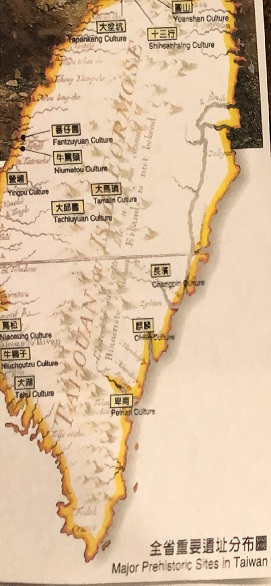
Black tea is popular but here called ‘red tea’ and liked local and of high quality, often an oolong if longjing or tieguanyin as their Iron Goddess of Mercy tea served stronger and better than elsewhere, and almost always in tiny cups. Other beverages also in these tiny cups, are served at their own best temperature.
On this island and in most of China, medicine and food are related, and can include ginseng, bird’s nests, other items for energy, strength, qi, another life-force, yin or yang if needed or wanted, or get one they read or heard about that very day. They know many sea foods from books written generations ago that tell them things such as their hot food can be pepper, ginger, chilies, or sugary ones, or fats good for their yin conditions, or cabbage, carrots, cress, or green beans for their yang ones. They know these illnesses can be fever, rash, burn, chronic constipation, or another yang condition they just heard about.
For these and other conditions, they prefer taking a food of the opposite type, or ingest a bu food that is easily digested to strengthen, supplement, or repair a particular tissue or condition such as those that are fowl, sea cucumber, ginseng, abalone, white tree-fungus, pangolin, or another low-fat, low calorie, non-irritating food that will not upset their stomach.
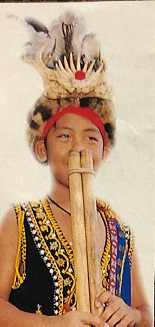 After eating, many do play a mouth
or nose organ or a lute-like string
instrument, some did have their
faces tattooed, most were done
at maturity if they are from one
of the two indigenous tribes that
do them for beauty, health, or to
show they belong to these two, or
they wanted or believe they need
it to be married; though that is not
always true. However, tattoos have
been illegal since the 1990s, since
then not always appreciated or
followed by these two Taiwanese
minority people from this island.
After eating, many do play a mouth
or nose organ or a lute-like string
instrument, some did have their
faces tattooed, most were done
at maturity if they are from one
of the two indigenous tribes that
do them for beauty, health, or to
show they belong to these two, or
they wanted or believe they need
it to be married; though that is not
always true. However, tattoos have
been illegal since the 1990s, since
then not always appreciated or
followed by these two Taiwanese
minority people from this island.
Most men and women with them are elders who got theirs at maturity believing or were told that ‘no Atayal person can marry without one’ or that ‘no Saislyat will get a suitor if no tattoo is seen on their face’. There are a few who do want a tattoo, perhaps their parents have one or to show it off or show they belong to one of these two indigenous populations. We saw many of them at the Taipei Culinary Exhibition or when they came to town perhaps to visit a skyscraper there.
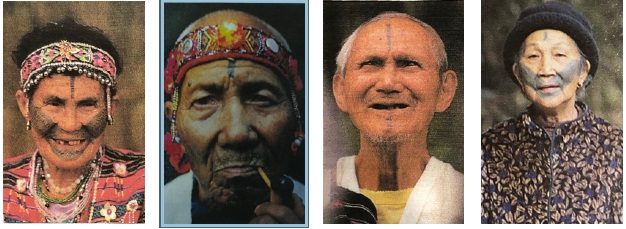
Those on this page are mostly from these tribal groups and done at maturity. Some of them told us to get one was painful; one fellow said some girls and young women run away not to get theirs, and that his male friends got theirs on a head-hunting trip with their fathers as then, they were unable to run away. One fellow said his father refused to let him be tortured when a few of his friends on a trip got theirs. They did say they felt unhappy with their tattoos.
Some girls told us got theirs when showing they could weave or do another womanly thing. Others said they were brain-washed into believing they needed one to find a beau and eventually get married. One fellow said his sister got hers after showing she could cook, then she was fifteen, now she is married, has two children, and pregnant with a third. All queried did say they adored their father, even the ones who had them do this painful rite of passage under duress.
Dates when they got theirs seem to be determined after a parental dream interpretation or bird divination. One chap had his when a tattoo artist showed up at his home and pressed ashes into patterns drawn on his face. He told us it took a few hours for a boy, an entire day for a girl; and now everyone knows he officially belongs to that tribe.
Another guy told us about eating in Taiwanese restaurants in China, the US, and elsewhere. He said he loved Three-cup Chicken, Slack Season Noodles, Pig’s Knuckles, and other Hakka foods he recognizes. Others spoke about those had at Taiwanese eateries such as the Tu Hsiao Yueh Hsiang, or Jen Dow branches in Taiwan and in China.
We did see recipes in Chinese and Taiwanese cookbooks, and on their web sites, but our space curtails including them in this magazine. You can seek them out and make them should you locate them; and we hope you do see and use them.
| Three-Cup Chicken |
|---|
3 Tablespoons sesame oil
1. Heat the oil, then add the wine, the soy sauce, and
sugar, and add and stir-fry the garlic and ginger in this
for one minute, then add the chili pepper pieces and
stir-fry another minute.
|
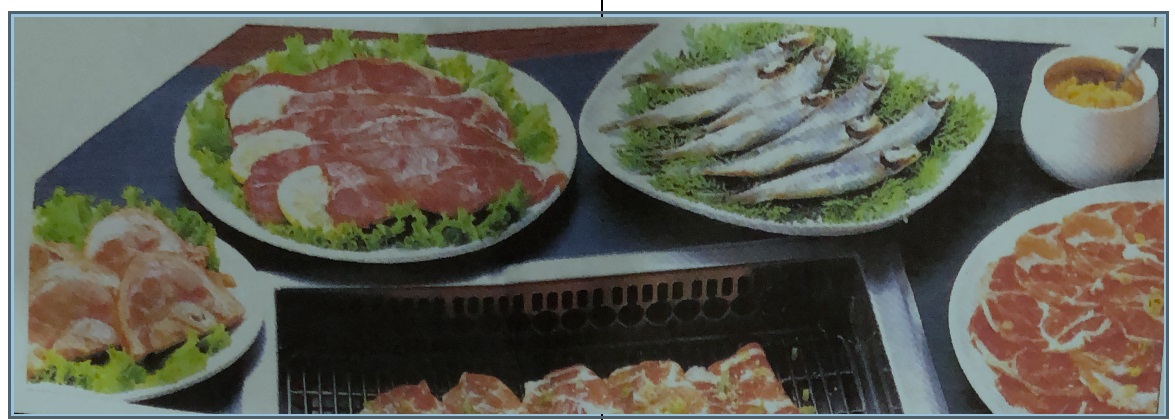

Copyright © 1994-2025 by ISACC, all rights reserved
Address
3 Jefferson Ferry Drive
S. Setauket NY 11720